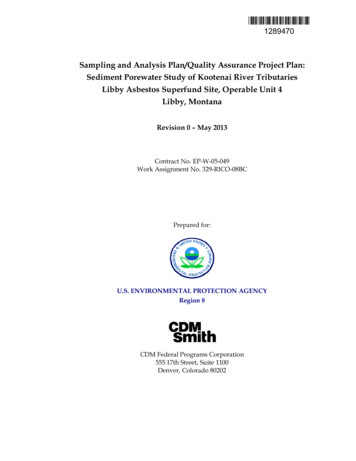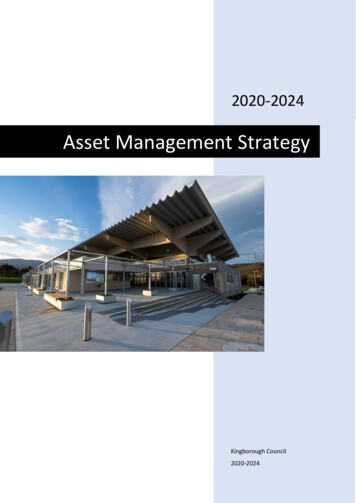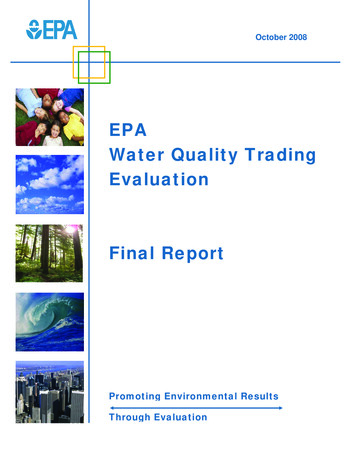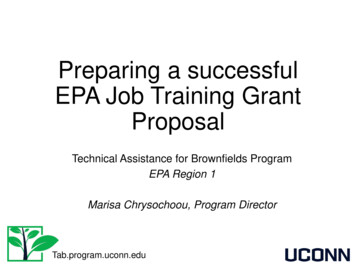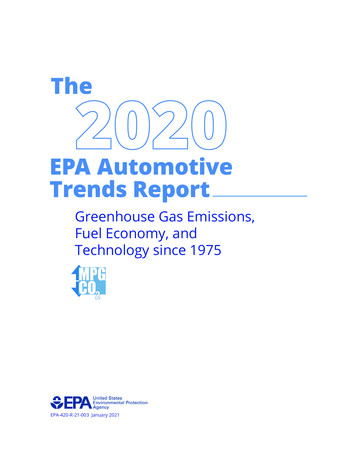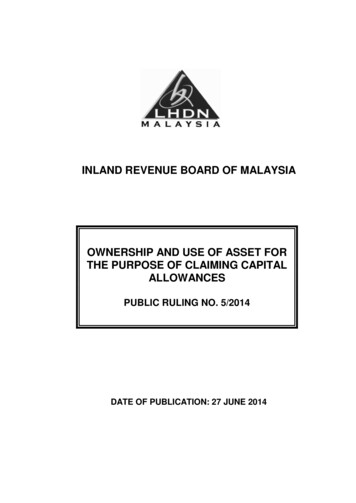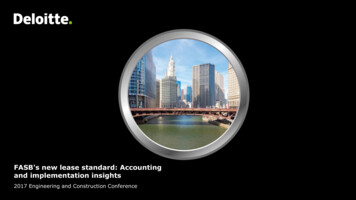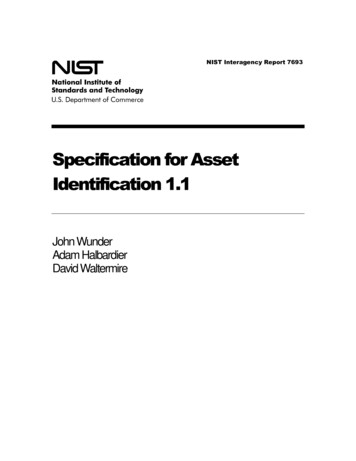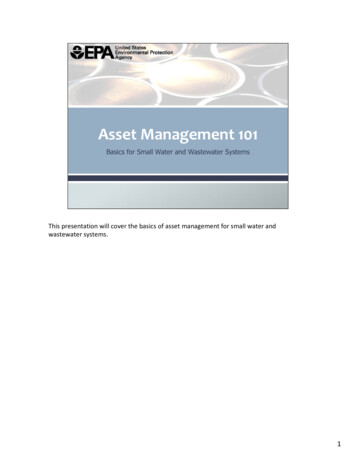
Transcription
Asset Management 101Basics for Small Water and Wastewater SystemsThis presentation will cover the basics of asset management for small water andwastewater systems.1
DisclaimerThis guidance does not confer legal rights or impose legalobligations upon any member of the public. While EPA hasmade every effort to ensure the accuracy of the discussion inthis presentation, the obligations of the regulated communityare determined by statutes, regulations, or other legallybinding requirements. In the event of a conflict between thediscussion in this presentation and any statute or regulation,this presentation would not be controlling.2Here is a disclaimer just basically saying that this presentation does not supersede anyregulations or legally binding agreements.2
of Asset ManagementThis presentation will talk about the who’s, what’s, when’s, where’s, why’s, and how’s ofasset management.3
Asset ManagementDescription for theWater Sector What is an asset? What is asset management? What are the benefits of implementingasset management principles?4We’ll go over‐What is an asset?‐What is asset management?‐What are the benefits of implementing asset management principles?We’re going to begin with talking a little bit about what assets are and what it means tomanage those assets.4
Assets are All the equipment, buildings, land,people, and other componentsneeded to deliver safe and cleanwatero Large, expensive, long-lived, and oftenburiedo Essential to protect public healthReturn Activated Sludge (RAS) Station and twoassociated Pad mounted Transformers (PMTs)Credit: City of Lincoln, IL5What are assets?Well assets are essentially all the equipment, buildings, land, people, and othercomponents needed to deliver safe and clean water.Assets are generally large pieces of complicated equipment or infrastructure that can bevery expensive. They usually last a fairly long time so utilities really want to keep them ingood shape. We all know that some of the infrastructure in this country is aging and failingat an alarming rate. And the reality is we don’t even know where it all is! It’s important toremember not only the large pieces of equipment that we see above ground, but also allthe equipment that it located underground. And it’s important to take note of all of this forthese assets are essential to protecting public health as well as for economic development.5
Asset Condition Over Time1980ExcellentPoorGoodVery PoorFairLife Elapsed20002020This example is drawn from w/w pipes, but the same6general patterns applies to all urban systemsWhen looking at the condition of assets over time, we’re seeing that more and moreassets are falling into the poor range and are projected to be in the very poor rangein the near future. Prior to the 1980s, the expansion and upgrade of assets wasunprecedented; and thinking of that, the resulting renewal investments for theseassets is also going to be unprecedented.6
EPA Infrastructure Gap Analysis The Gap Analysis Was Released-- WEFTEC 2002 The Purpose -- To reach acommon quantitativeunderstanding of the (FundingGap) the potential magnitude ofincrease in investment neededto:o Address growing populationand economic needs, ando Renew our existing ort.pdf7Following up that, a Gap Analysis was released to provide a starting point forthinking about the challenge of how much it’s going to cost to maintain and replacethese assets. The Gap Analysis essentials projects the amount of gap of fundingthat will be needed for this investment in our assets. The Gap Analysis can be foundat: http://www.epa.gov/ogwdw/gapreport.pdf7
An Emphasis on Asset Management Emergedas a Central Response to the Gap AnalysisNo Revenue GrowthScenarioTotal Payment Gap (20 Years)(Average in Billions of Dollars)Revenue GrowthScenarioTotal Payment Gap (20 Years)(Average in Billions of Dollars)CleanWaterDrinkingWaterCapital 21 45 161O&M 10 0 263Total 31 45CleanWaterDrinkingWaterCapital 122 102O&M 148Total 271(Annual Rate of Increase - 3% Real)8The Gap Analysis showed the amount of funding that is needed for our water sectorassets – through repair, rehabilitation, and replacement. What really came out of itwas the notion that we need to manage our assets, throughout their entire life cycle.Managing assets is just really knowing what we have, how they should bemaintained, and how much it will cost to maintain them until they are no longeruseful.8
Asset Management is “A process for maintaining a desiredlevel of customer service at the bestappropriate cost.”9One simple definition we have for asset management is thinking of it as “A process formaintaining a desired level of customer service at the best appropriate cost.”‐When we say “Desired level of service” this is what utilities want their assets to provide‐And when we say “Best appropriate cost” this is the lowest life cycle cost (but it’s notnecessarily without cost)Basically we want to provide safe, reliable service while thinking about what the costs willbe for those services. Essentially we’re thinking more like a business.9
Asset Management includes . Building an inventory of yourassets Scheduling and trackingmaintenance tasks through workorders Managing your budgeted andactual annual expenses andrevenue10Comprehensive asset management includes:1. Building an inventory of your assets2. Scheduling and tracking your maintenance tasks through work orders, and3. Managing your budgeted and actual annual expenses and revenueDoing all of these will help you determine your system’s future needs.10
Asset Management will Give systems a documented understanding ofo the assets they have,o how long they are going to last, ando how much it’s going to cost to repair, rehabilitate, or replace them Provides financial projections and allows the utility to see ifo rates and other revenue generating mechanisms are enough to stayin the business of safely providing drinking or clean water tocustomersGive you the basis to make good decisions11Implementing asset management will help you identify all the assets that a utility has, howlong they are going to last, and how much it’s going to cost to repair, rehabilitate, orreplace them.All of this information will allow utilities to see financial projections 5 years from now andeven 10 years from now. Knowing how much money is needed to fund maintenance andinvestments in assets will help the utility determine if rates and other revenue generatingmechanisms are enough.11
Asset Management will help you stop and/or12Basically asset management will help you stop:Having your money go down the drainand/orFlushing your money down the toilet12
The 5 Core QuestionsAn Asset ManagementFrameworkThere are five Core Questions in anAsset Management Framework1.What Is the Current State of the Utility’s Assets?2.What Is the Utility’s Required Sustained Level of Service?3.Which Assets Are Critical to Sustained Performance?4.What Are the Utility’s Best “Minimum Life-Cycle Cost” CIPand O&M Strategies?5.What Is the Utility’s Best Long-term Financing Strategy?13Asset management best practices aim to improve utility operations. Utilities will becomemore familiar with these approaches as an asset management program is implemented. Agood starting point for any size system is the 5 Core Questions framework. This frameworkwalks you through all the major activities associated with asset management and can beimplemented at the level of sophistication reasonable for a given system.The 5 core questions of an asset management framework are1. What Is the Current State of the Utility’s Assets?2. What Is the Utility’s Required Sustained Level of Service?3. Which Assets Are Critical to Sustained Performance?4. What Are the Utility’s
An Asset Management Framework There are five Core Questions in an Asset Management Framework . 1. What Is the Current State of the Utility's Assets? 2. What Is the Utility's Required Sustained Level of Service? 3. Which Assets Are Critical to Sustained Performance? 4. What Are the Utility's Best "Minimum Life-Cycle Cost" CIP and O&M .
